Project Blue Book was an official United States Air Force investigation into UFOs. Spanning from March 1952 to the end of 1969, Blue Book was the third such effort, succeeding Project Sign (1947-1948) and Project Grudge (1948-1951). While studying a total of 12,618 UFO reports during its tenure, Blue Book survived a number of iterations and leaders before culminating in 1968 with an analysis by Dr. Edward Condon of the University of Colorado.
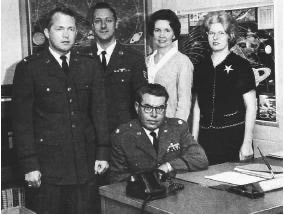
Blue Book was shuttered in December 1969 and represented the final effort by U.S. military forces to understand the UFO phenomenon until the U.S. Navy authorized the Advanced Aerial Weapons Systems Applications Program (AAWSAP). Sometimes referred to as the Advanced Aerospace Threat Identification Program (AATIP), that effort ran from 2007 to either 2012 or 2017, depending on conflicting sources.
Previous Programs and Formation
Following a series of “flying saucer” or “flying disc” sightings in the summer of 1947, the U.S. Air Force asked General Nathan Twining to assemble a panel of experts to try to understand the nature and origin of these reports. The results of that effort were summarized in a document more commonly known as the “Twinning memo,” which, among other conclusions, stated that the observation seemed to represent real craft, were not fictitious or visionary and merited further study.
Twinning’s memo more or less led to the formation of Project Sign, which studied UFO reports from the end of 1947 until the end of 1948. According to Edward Ruppelt, who was the first head of Project Blue Book, the Project Sign team created a document known as the “Estimate of the Situation,” which offered the extraterrestrial hypothesis as a possible explanation for UFOs. No copies of the “Estimate” exist.
Unsatisfied with the team’s conclusions and direction, Air Force leaders terminated Sign and created Project Grudge, which ran from 1948 to the end of 1951. Unlike Sign, which many hailed as a serious scientific effort, Grudge has been labeled a public relations campaign designed to quell interest in UFOs by offering mundane explanations for many of the cases, even when those explanations were far-fetched. In his 1956 book “The Report on Unidentified Flying Objects,” Ruppelt referred to Grudge as “The Dark Ages” of UFO research and later stated that even that project’s name reflected its debunking and minimizing mandate.
Similarly unsatisfied with the conclusions of Grudge, and following a new wave of UFO sightings in late 1951 and early 1952, the Air Force terminated Grudge and formed Project Blue Book.
The Edward Ruppelt Era 1952 – 1953
According to Captain Ruppelt, who was the first of many Project Blue Book leaders, USAF General Charles P. Cabell was unsatisfied with the conclusions of Grudge and wanted a more open-minded effort. This conclusion was apparently bolstered by the addition of General William Garland to Cabell’s staff, as Garland had reportedly witnessed a UFO himself and was equally dissatisfied with the dismissive nature of Grudge.
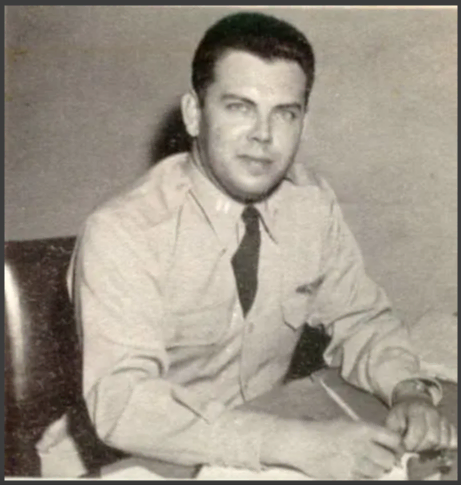
Like Grudge, Ruppelt claimed Blue Book’s name represented the attitude of the investigation team. Specifically, he said the name came from the blue booklets used by college students when taking exams because so many high-ranking officials were watching his team’s effort.
Reports indicate Ruppelt was selected to lead Blue Book because he was a decorated member of the Army Air Corps during World War two, and after the war, he’d earned a degree in aeronautics. During his tenure as project leader, Captain Ruppelt veered away from the controversial “flying saucer” and “flying disc” terms which the public was already associating with extraterrestrial visitors, and replaced them with the more ambiguous “Unidentified Flying Object.”
In his book “Captain Edward J. Ruppelt: Summer Of The Saucers,” author Michael Hall said Ruppelt wanted to avoid the factionalism of Sign, where some staff members vehemently favored the extraterrestrial hypothesis and others were equally opposed.
“Ruppelt not only took the job seriously but expected his staff to do so as well,” wrote Hall. “If anyone under him either became too skeptical or too convinced of one particular theory, they soon found themselves off the project,” Ruppelt highlighted this attitude in his own book, noting how very early in the Blue Book effort, he dismissed three staffers who were either “too pro” or “too con” either theory.
Among the many contributions made during his tenure, Ruppelt streamlined the way reports were made by military officials, even going so far as having the Battelle Memorial Institute create a standardized questionnaire used by investigators. After computerizing the project’s findings up to 1954, about 3,200 cases total, Battelle ran a massive scientific and statistical analysis of the reports. Those findings were assembled and presented in a report known as “Project Blue Book Special Report #14.”
Ruppelt and his team investigated numerous cases during his tenure. But according to famed UFO researcher Jacques Vallee, Ruppelt’s team avoided cases involving reports of landings and/or occupants, instead focusing on aerial sightings.
In his book "UFOs, the Military, and the Early Cold War Era," author Michael D. Swords wrote, "Ruppelt would lead the last genuine effort to analyze UFOs."
The Robertson Panel
Following a series of sightings in and around July 1952, the Central Intelligence Agency formed a panel of engineers, physicists, and meteorologists headed by California Institute of Technology physicist H.P Robertson to analyze Blue Book’s results. Known as the Robertson Panel, this group included Dr. J. Allen Hynek, an astronomer who had consulted on Sign and Grudge and who was now assisting Ruppelt with Blue Book.
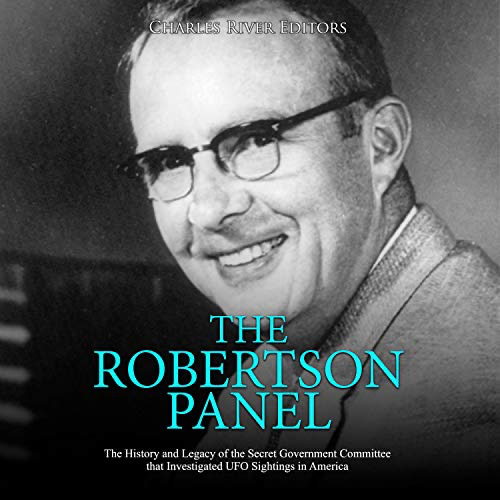
The Robertson Panel first convened on January 14, 1953, and heard testimony from experts, including Hynek and Ruppelt, who presented six years of data collected and analyzed by Blue Book. After 12 hours of analysis and deliberation, the panel determined that most UFO reports likely had prosaic explanations, and the remaining unexplainable reports did not merit any further study.
The Robertson Panel issued a single report which stated that “low-grade” UFO reports were clogging the investigation apparatus, potentially causing intelligence officials to miss actual threats. The panel also recommended that the Air Force employ experts to debunk reports so the public would lose interest while working with the entertainment industry to ridicule believers. Toward this end, the report suggests that civilian UFO groups, which were already sprouting up, "should be watched because of their potentially great influence on mass thinking… The apparent irresponsibility and the possible use of such groups for subversive purposes should be kept in mind."
In February 1953, Ruppelt left Blue Book for a temporary assignment, and when he returned, he found his staff had been reduced from more than ten to only two. As a result, Ruppelt recommended that the investigation of UFOs be transferred to the 4602nd Air Intelligence Service Squadron (AISS), which was better staffed and equipped.
At the same time, in February 1953, the Air Force issued Regulation 200-2, which only permitted the public discussion of UFO cases that were considered solved and required unexplained sightings to remain classified. Ruppelt left Blue Book in August 1953.
In December 1953, Joint Army-Navy-Air Force Regulation number 146 made it a crime to discuss UFO cases with unauthorized individuals, further diminishing the abilities of Blue Book to seek outside help. That same month, the Air Force followed the frustrated Ruppelt’s recommendation by placing the bulk of UFO investigations under the jurisdiction of the 4602nd Air Intelligence Squadron of the Air Defense Command. After that, Blue Book mostly investigated trivial UFO reports, while those with potential intelligence and national security implications were moved to the 4602nd.
In August of 1954, General Nathan Twining, now Air Defense Chief of Staff, issued an update to regulation 200-2 to codify the 4602nd’s responsibilities away from Blue Book. Among other things, this update defined UFOs that warranted study as "any airborne object which by performance, aerodynamic characteristics, or unusual features, does not conform to any presently known aircraft or missile type, or which cannot be positively identified as a familiar object."
Although Blue Book remained the public face of UFO investigations, this new order essentially stripped the group of any real power.
The Hardin Era
In March 1954, Captain Charles Hardin was appointed the new head of Blue Book. According to reports, Hardin was more than happy to let the AISS investigate most UFO reports. Ruppelt wrote that this arrangement suited Harding perfectly, as he "thinks that anyone who is even interested [in UFOs] is crazy. They bore him."
Under Harding, the Air Force decided Blue Book should be less about investigating UFOs and instead should work to reduce the number of unexplained sightings whenever possible.
The Gregory Era
Captain George T. Gregory took over Blue Book’s lead in late 1956, replacing Harding. In his book “The UFO Book: Encyclopedia of the Extraterrestrial,” author Jerome Clark stated that Gregory took Blue Book "in an even firmer anti-UFO direction than the apathetic Hardin.”
During Gregory’s tenure, the 4062nd was dissolved, and all significant UFO reports were to be investigated by the 1066th Air Intelligence Service Squadron. As a result, Blue Book staff performed almost no investigations during his tenure.
Gregory’s primary contribution to the effort was the reduction of unexplained events by changing “possible” explanations to “probable” ones. For instance, if an investigation determined that a sighting was a “possible meteor,” it was changed to “probable.” As a result, the number of unexplained sightings dropped from 20-25% during the Ruppelt era to less than 1% under Gregory.
The Friend Era
Major Robert J. Friend took over for Gregory in 1958, and according to reports, he tried to reverse the apathy and lack of organization left behind by his two predecessors. However, according to Clark, "Friend's efforts to upgrade the files and catalog sightings according to various observed statistics were frustrated by a lack of funding and assistance."
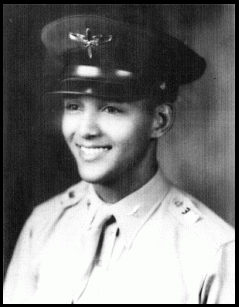
During Friend’s term, Blue Book was investigated by the CIA and the U.S. Congress to determine if the project was covering up UFO evidence. This led to a temporary increase of Blue Book staff to three military personnel and one civilian secretary, but those changes were soon reversed. When Friend left Blue Book in 1963, he said the effort was useless and should be dissolved.
The Quintanilla Era
Major Hector Quintanilla, the last Air Force officer to lead Blue Book, took over for Friend in August 1963. Quintanilla resumed efforts to discredit and minimize UFO reports, leading Physicist and UFO researcher Dr. James E. McDonald to state that the major was “not competent” as an investigator or from a scientific perspective.
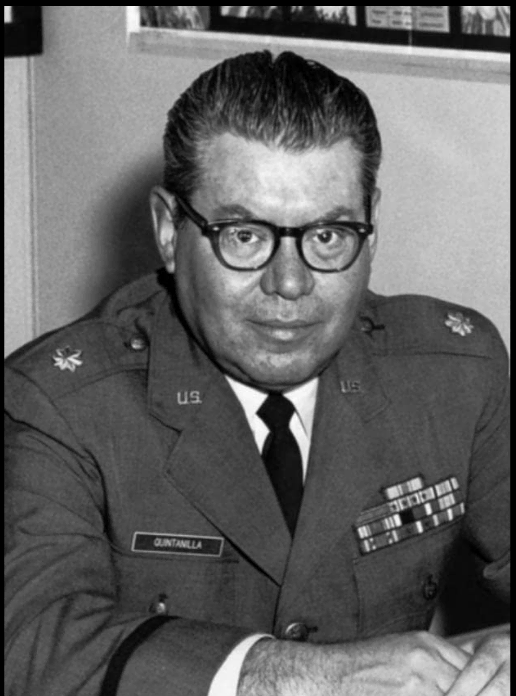
During Quintanilla’s tenure, skepticism over Blue Book’s lack of scientific methodology and accusations that the effort was a deliberate cover-up grew substantially. This issue came to a public head when Quintanilla’s team investigated a 1965 sighting in Texas. Ignoring radar data from Tinker Air Force Base near Oklahoma City, which according to the local Highway Patrol, said they had tracked up to four objects dropping from 22,000 feet altitude to 4,000 feet in “just a few seconds,” Quintanilla’s team determined that the sightings were simply misidentifications of Jupiter or other bright stars in the sky.
In response, the director of the Oklahoma Science and Art Foundation Planetarium, Robert Riser, wrote a widely circulated rebuke of Blue Books' findings.
“That is as far from the truth as you can get,” wrote Riser of the Blue Book explanation. “These stars and planets are on the opposite side of the earth from Oklahoma City at this time of year. The Air Force must have had its star finder upside-down during August.”
This happened again on April 17, 1966, when two police officers near Ravenna, Ohio, spent over thirty minutes chasing what they described as a silvery, disc-shaped object that flew as high as 1,000 feet and sometimes as low as 50 feet. Known as the “Portage County UFO Chase,” Blue Book investigators never spoke to any of the civilian ground witnesses and ultimately determined that the two officers, one of whom was an experienced tail gunner in the Korean War, had initially chased a communications satellite, and then the planet Venus.
Once again, public outcry and the vehement rejection of the explanation by the two police officers led to charges of sloppy investigation methodology and even a cover-up by the Blue Book staff.
"The Air Force has suffered a great loss of prestige in this community,” wrote Ohio Congressman William Stanton of Blue Book’s explanation. “Once people entrusted with the public welfare no longer think the people can handle the truth, then the people, in return, will no longer trust the government."
Possibly the most well-known debunking effort under the Quintanilla era occurred in 1966, when residents in and around Ann Arbor, Michigan, experienced a series of UFO sightings, including reports by police officers, college students, farmers, and everyday citizens, most of whom reported a distinct, flying disc-shaped craft. Quintanilla dispatched Hynek to investigate, and within hours the astronomer had completed his investigation and called a press conference. At the conference, Hynek dismissed the sightings as misidentified stars and planets and swamp gas, which he said can ignite and give the illusion of a flying craft. The eyewitnesses and media considered the second explanation so ridiculous that the term “swamp gas” has become nearly synonymous with the extraordinary lengths skeptics will go to when trying to explain away UFO sightings.
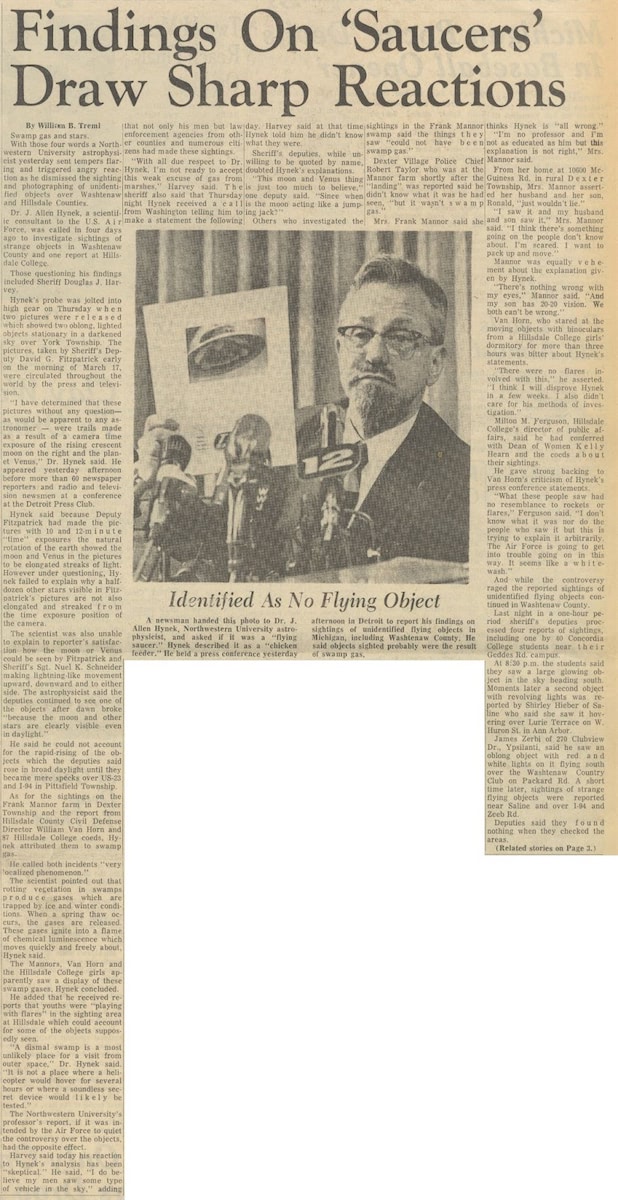
Congressional Hearings and the Condon Committee
After local Michigan congressman and future, U.S. President Gerald R. Ford demanded better answers to the UFO question and to his constituent’s sightings, the United States Congress held the first and only 20th century UFO hearings. The inconclusive results of those hearings led to the enlistment of an outside academic team to evaluate and hopefully better explain the UFO question.
Led by Professor Edward U. Condon, the University of Colorado UFO Project (More commonly known as the Condon Committee) was formed in 1966. In 1968, the committee presented their findings in the Scientific Study of Unidentified Flying Objects, also known as the Condon report.
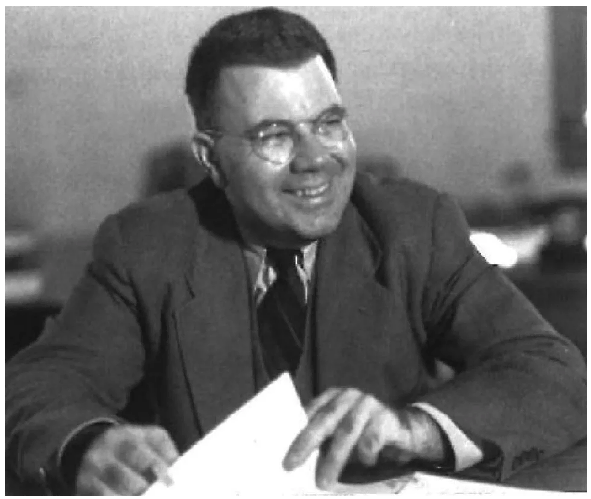
Issued in November 1968 and made public in January 1969, the 1,485-page report included data from Blue Book as well as civilian UFO research groups. That report ultimately determined that most, if not all, UFO sightings could be easily explained as misidentifications of conventional craft or astronomical phenomena and that there was no scientific value to warrant further investigations. Many have credited these findings with forming and perpetuating the dismissive attitude toward UFOs held by most mainstream scientists ever since.
Critics have charged Condon with a flawed conclusion based on the hundreds of unexplained cases included in the report. Condon was also accused of aiding the Air Force’s cover-up of scientifically valid cases and of starting his analysis with a predetermined conclusion.
End of Blue Book
Following the Condon Committee’s report, the U.S. Air Force shuttered Blue Book in 1969. The USAF ultimately issued Fact Sheet 95-03, which stated the following:
From 1947 to 1969, the Air Force investigated Unidentified Flying Objects under Project Blue Book. The project, headquartered at Wright-Patterson Air Force Base, Ohio, was terminated December 17, 1969. Of a total of 12,618 sightings reported to Project Blue Book, 701 remained "unidentified."
The decision to discontinue UFO investigations was based on an evaluation of a report prepared by the University of Colorado entitled "Scientific Study of Unidentified Flying Objects;" a review of the University of Colorado's report by the National Academy of Sciences; previous UFO studies and Air Force experience investigating UFO reports during 1940 to 1969.
As a result of these investigations, studies, and experience gained from investigating UFO reports since 1948, the conclusions of Project Blue Book were:
No UFO reported, investigated, and evaluated by the Air Force has ever given any indication of threat to our national security.
There has been no evidence submitted to or discovered by the Air Force that sightings categorized as "unidentified" represent technological developments or principles beyond the range of present-day scientific knowledge.
There has been no evidence indicating the sightings categorized as "unidentified" are extraterrestrial vehicles.
With the termination of Project Blue Book, the Air Force regulation establishing and controlling the program for investigating and analyzing UFOs was rescinded. Documentation regarding the former Blue Book investigation was permanently transferred to the Modern Military Branch, National Archives and Records Service, and is available for public review and analysis.
Since the termination of Project Blue Book, nothing has occurred that would support a resumption of UFO investigations by the Air Force.
There are a number of universities and professional scientific organizations that have considered UFO phenomena during periodic meetings and seminars. A list of private organizations interested in aerial phenomena may be found in "Encyclopaedia of Associations", published by Gale Research. Interest in and timely review of UFO reports by private groups ensures that sound evidence is not overlooked by the scientific community. Persons wishing to report UFO sightings should be advised to contact local law enforcement agencies.
Legacy
Although rife with charges of shoddy methods, outright debunking efforts, and even an organized cover-up, Project Blue Book remains the longest-running official effort to study UFOs by any branch of the U.S Military.
As of 2022, Blue Book is still infamous, resulting in numerous documentaries, books, TV shows, and movies highlighting or inspired by the 17-year investigation.